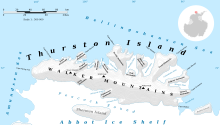geo.wikisort.org - Mountains
Landfall Peak (72°0′S 102°1′W) is a prominent peak-shaped landmark near the extreme west end of Thurston Island, Antarctica, about 8 nautical miles (15 km) east-northeast of Cape Flying Fish and 0.5 nautical miles (0.9 km) northwest of Mount Gimber. It was discovered by members of the United States Antarctic Service in flights from the USS Bear in February 1940, and photographed at that time by E.B. Perce. The peak was plotted from air photos taken by U.S. Navy Operation Highjump in December 1946, and was observed by personnel of the U.S. Navy Bellingshausen Sea Expedition in February 1960. It was so named by the Advisory Committee on Antarctic Names because rock exposures on the peak serve as a mark for ships approaching Thurston Island from the west.[1]


See also
- Mountains in Antarctica
Maps
- Thurston Island – Jones Mountains. 1:500000 Antarctica Sketch Map. US Geological Survey, 1967.
- Antarctic Digital Database (ADD). Scale 1:250000 topographic map of Antarctica. Scientific Committee on Antarctic Research (SCAR). Since 1993, regularly upgraded and updated.
References
- "Landfall Peak". Geographic Names Information System. United States Geological Survey. Retrieved 29 May 2013.
![]() This article incorporates public domain material from the United States Geological Survey document: "Landfall Peak". (content from the Geographic Names Information System)
This article incorporates public domain material from the United States Geological Survey document: "Landfall Peak". (content from the Geographic Names Information System)
На других языках
[de] Landfall Peak
Landfall Peak (englisch für Landungsspitze) ist ein markanter Berg im äußersten Westen der Thurston-Insel vor der Eights-Küste des westantarktischen Ellsworthlands. In den Walker Mountains ragt er 13 km ostnordöstlich des Kap Flying Fish auf.- [en] Landfall Peak
Другой контент может иметь иную лицензию. Перед использованием материалов сайта WikiSort.org внимательно изучите правила лицензирования конкретных элементов наполнения сайта.
WikiSort.org - проект по пересортировке и дополнению контента Википедии
